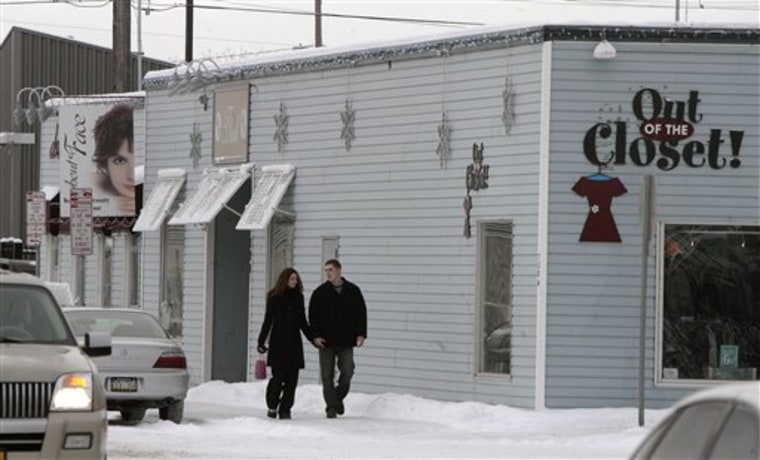In a city where fashion sense has always played a distant second to staying warm, a cluster of boutiques in the budding "SoNo" district, south of Alaska's only Nordstrom store, does a surprisingly brisk business in $50 body lotions and $180 designer jeans.
The homage to New York City's trendy SoHo district is just one of the many signs that this once-unruly oil-boom town at the edge of the American wilderness has been tamed.
In some respects, Anchorage could even be called sophisticated.
"Anchorage has really changed since I moved here 30 years ago," said Ellen Arvold, owner of the Out of the Closet luxury consignment shop, where leopard-print Prada ballet flats and Louis Vuitton handbags are big sellers. "People don't think there's a market for us, but there really is."
Strip malls have replaced strip clubs, big-box stores draw more customers than bars, and residential neighborhoods have supplanted the RV parks that once sprawled across the state's most populous city.
"Anchorage has kind of grown up," said longtime resident Charles Wohlforth, who writes the annual Alaska travel guide for Frommer's. "It's left its adolescence and is becoming more of a mature city."
The tumultuous years of oil booms and busts in the 1970s and '80s have given way to two decades of steady growth, and Anchorage's economy has expanded to include burgeoning retail, health care and tourism industries.
The influx of non-oil, non-military jobs has altered the city's demographics, making it less like a frontier town.
At one time, men far outnumbered women in Alaska. But in 2006, the city of 270,000 had 102 men for every 100 women, state demographer Eddie Hunsinger said. The ratio for the rest of Alaska was 108 to 100.
Leese Lloyd and Ashley Brusven, young baristas who grew up in Anchorage, said the notion that the city has an overabundance of men is an outdated stereotype.
"Where are they?" Brusven joked as customers in the adjacent New Sagaya City Market surveyed stuffed grape leaves, caprese, baklava and other un-Alaskan foods.
The city is also reshaping its modest skyline with a $100 million museum expansion, a $93 million convention center and a parking garage with room for 830 vehicles. Companies are putting up new hotels and glass-plated office buildings.
Development has its critics. Many Alaskans see Anchorage as increasingly out of sync with the rest of the state, prone to sprawl, traffic, crime and the other usual urban ills.
"Rural Alaskans have a love-hate relationship with Anchorage," said Stephen Haycox, a history professor at the University of Alaska-Anchorage. "What they hate is that people in Anchorage don't have a good understanding of rural Alaska, which is a truly different world. But they love that Anchorage has neat things to buy and neat things to do."
The growth has triggered a steady exodus north to the state's first suburban community, the farm and sled-dog country of the Matanuska-Susitna Valley. About 2,000 people leave Anchorage each year for Mat-Su.
Anchorage's latest promotional campaign, called "Big Wild Life," depicts city life as a mix of bold outdoorsy activities and urban comforts. The Web site of the Anchorage Convention and Visitors Bureau highlights the city's spas, opera and symphony, and downplays the long, cold winters by describing Anchorage as "a city of lights and flowers."
While Anchorage is no longer the rugged place Jack London knew, many characteristics of classic Alaska remain. Winter temperatures can dip to minus-20 and daylight dwindles after five hours in December. The peaks of the Chugach Mountains form an imposing backdrop, a striking reminder of the wilderness beyond.
Grizzlies, black bears and moose are still a common sight. Moose browse along the popular paved trail system, trot through cookie-cutter condo developments and occasionally attempt to navigate fast-moving traffic.
In November, a bull moose tangled his rack in a municipal Christmas light display before strolling into the courtyard at a lounge and dance club in SoNo. With the dead string of lights dangling from his noggin, the moose grew tipsy on fermented crabapples, prompting the local paper to nickname him "Buzzwinkle."
